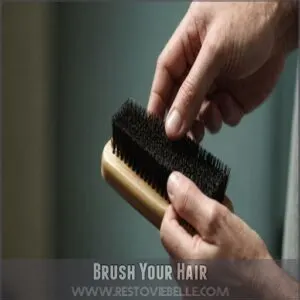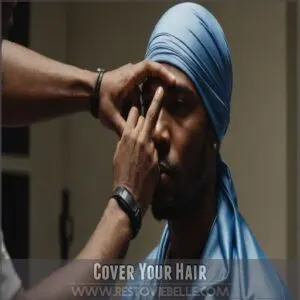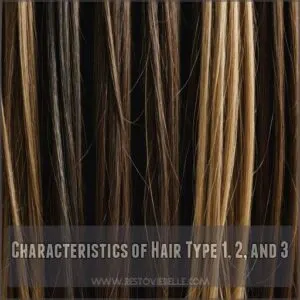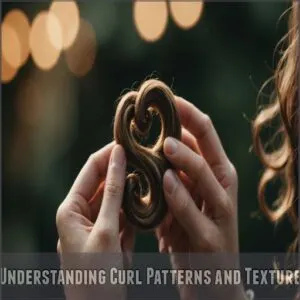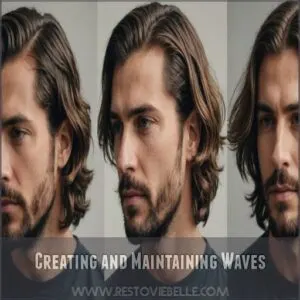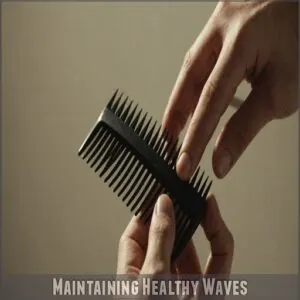This site is supported by our readers. We may earn a commission, at no cost to you, if you purchase through links.
 Can white people get waves? Absolutely! Waves are all about technique and patience, not just hair type.
Can white people get waves? Absolutely! Waves are all about technique and patience, not just hair type.
If your hair’s slightly wavy or curly, you’re a step closer. Start by washing your hair, then regularly brush it in the direction you want your waves.
Use a good moisturizer to keep it healthy, and wear a durag at night to lock in those waves. Trimming helps maintain the style, too.
Think of it as training your hair to follow the wave! Sounds tricky? Maybe, but remember, with the right approach, waves can become your crowning glory. Curious about brushing secrets?
Table Of Contents
- Key Takeaways
- Can White People Get Waves
- Achieving Waves on Caucasian Hair
- Hair Type and Wave Pattern
- Creating and Maintaining Waves
- Overcoming Common Challenges
- Maintaining Healthy Waves
- Frequently Asked Questions (FAQs)
- Can any hair type get waves?
- Can everyone get 360 waves?
- Can guys with straight hair get waves?
- Can hair waves be natural?
- Do waves damage straight hair types?
- How long does it take to see waves?
- What products are best for softening hair?
- Are there specific brushes for straight hair waves?
- Can dyed hair achieve the wave pattern?
- Conclusion
Key Takeaways
- You can achieve waves with the right techniques, regardless of your hair type or ethnicity. Consistent brushing and using a durag are essential.
- Understanding your hair texture and curl pattern helps tailor your approach to creating waves, maximizing your hair’s wave potential.
- Keep your hair moisturized and healthy using specific wave-friendly products like natural oils and curl-enhancing shampoos.
- Overcome challenges like frizz and uncooperative hair, especially for those with 2a hair type, by understanding that utilizing the right products for 2a hair, such as lightweight serums and mousses, can help. Overcome challenges like frizz and uncooperative hair by choosing the right products and maintaining a consistent care routine, even when dealing with different weather conditions.
Can White People Get Waves
Yes, you can absolutely get waves, regardless of your ethnicity!
While it might take a bit more effort depending on your hair type, with the right techniques and consistency, you can achieve that stylish wavy look.
Understanding Hair Texture and Type
Understanding your hair texture and type is key to achieving stylish waves.
Caucasian hair often varies in porosity, density, and elasticity, which influences wave patterns.
For the best results, you can utilize specific wave hair products, explore wave products.
Think of your hair as a unique garden; some plants (hair types) need more attention to thrive.
Scalp health plays a vital role here.
Regularly check your hair’s growth and adapt your styling methods accordingly.
A little patience with the right approach can reveal wave potential.
The Role of Genetics in Hair Texture
Your hair texture isn’t just about what you see in the mirror; it’s heavily influenced by your genetics, ancestry, and family history.
Think of it like an inherited family recipe, passed down through generations.
For Caucasian hair, creating waves might need more effort due to the genetic blueprint you were handed.
But don’t worry, with some dedication and the right techniques, you can master wave patterns!
How to Determine Your Hair Type
Just like sleuthing clues to solve a mystery, discovering your hair type opens doors to understanding how waves might suit you.
Feel your hair strand’s thickness, a kernel of corn or wispy like silk?
Explore density, running fingers through, spotting the ground peeking through or not.
What’s your curl pattern, silky straight or bouncing spirals?
Finally, check porosity; does water stay or slip through?
These insights guide your wave journey.
Achieving Waves on Caucasian Hair
If you’re looking to achieve waves on Caucasian hair, you’ll need to focus on consistent hair care.
By washing thoroughly, brushing regularly, and using a durag, you can help encourage those wave patterns you’re after.
Wash Your Hair
Kick off your wavy hair journey by focusing on a solid hair cleansing routine.
But remember, stylist preference for hair washing varies, depending on the occasion, like before a haircut.
Use wave shampoo every few days to avoid product build-up that messes with your wave pattern.
Consider the water temperature, too—lukewarm water is your friend.
This helps your hair care routine stay on point, setting the stage for brushing and styling success.
Brush Your Hair
After washing, grab your boarhair brush and embrace those brushing techniques.
With a consistent brushing frequency, glide it in the direction your hair grows to encourage that perfect wave pattern.
No need for a fancy wave brush; just keep your technique sharp.
Remember, hair brushing isn’t just maintenance—it’s an art form, much like sculpting your own style masterpiece.
Cover Your Hair
Having washed and brushed your hair, it’s time to protect those hard-earned waves.
Choosing the right durag is key; silk or satin durags offer superior hair protection and prevent breakage.
A proper nighttime routine includes carefully wrapping your hair to maintain your wave pattern.
Remember, consistent use is essential for wave maintenance.
Using a durag helps lock in moisture and shape, preventing frizz and maximizing your wave pomade’s effectiveness.
Get Maintenance Trims
To keep your waves looking sharp, regular maintenance trims are key.
A fresh shape-up keeps the wave pattern neat and defined.
Consider these:
- Barber recommendations for the best results.
- Trim frequency every 2-3 weeks.
- Explore fade styles for added flair.
- Master shape-up tips for clean lines.
- Use proper trimming tools to avoid errors.
Hair Type and Wave Pattern
To achieve waves, understanding your hair type is essential, as it directly affects wave formation.
Hair types vary from straight to curly, each with unique patterns that can impact how easily waves develop.
Characteristics of Hair Type 1, 2, and 3
You’ve got your tools ready for styling; now let’s understand hair types. Hair Type 1 is straight, often silky, but a bit stubborn for waves. Type 2 is naturally wavy, offering a playful texture that dances well with a wave cream. Type 3 is curly, perfect for dynamic wave patterns. Embrace each type with the right approach!
| Type | Description | Style Suitability |
|---|---|---|
| 1 | Straight | Challenging |
| 2 | Wavy | Adaptable |
| 3 | Curly | Ideal for Wave Patterns |
Understanding Curl Patterns and Texture
Understanding curl patterns and texture is key to mastering waves on Caucasian hair.
Hair texture basics involve different curl pattern types, ranging from straight to coiled, with specific patterns like 2C Hair Waves featuring defined S-shaped waves from the roots and a blend of wavy and curly textures. Hair texture basics involve different curl pattern types, ranging from straight to coiled.
To enhance and define your waves, consider using products like those found in a Wave Hair Spray Collection.
Here’s a quick rundown:
- Type 1: Straight, no curls.
- Type 2: Wavy, loose S-shaped curves.
- Type 3: Curly, springy loops.
- Type 4: Coily, tight curls.
Recognizing these variations helps tailor your styling approach, ensuring better wave patterns and satisfying results.
How Hair Type Affects Wave Achievability
Hair texture plays a big role in wave potential.
If your hair’s wavier or curlier, it’s got more wave potential than poker-straight locks.
Genetics also weigh in; some folks just have the knack for waves.
Think of hair types like different breeds—each with unique traits.
So, wave patterns depend on hair type, curl patterns, and thickness.
Among Caucasians, some individuals may have the rarest hair type, such as Type 1A hair characteristics, while others can achieve wavy styles with the right techniques. Even among Caucasians, the wave story varies with each unique hair type.
Creating and Maintaining Waves
To create and maintain waves, focus on brushing techniques and consistency as your main allies.
Wearing a durag not only protects your waves but also enhances their definition, adding a touch of style every day.
Brushing Techniques for Wave Creation
Mastering wave creation hinges on your brushing technique.
With the right approach, you’ll sculpt those waves into a masterpiece.
Here’s what you need to know:
- Use a soft-bristled wave brush for gentle wave pattern control.
- Brush in a circular motion, starting from the crown and working outwards.
- Adjust brushing duration based on your hair’s needs and desired wave definition.
Experiment to find what works best for you!
The Importance of Consistency in Brushing
You’ve got your brushing techniques down; now, let’s talk consistency.
Imagine brushing your hair as a daily routine—like brushing off yesterday’s worries.
For wave progression and definition, consistency is key.
Using the right products, like Paul Mitchell MVRCK Pomade for wave management, can also help you achieve desired results.
Use that wave brush every day, and watch your hair growth transform into those 360 waves.
Keep your brushing frequency regular to maintain your wave pattern.
A little effort daily, and you’re set!
| Task | Frequency | Tool Needed |
|---|---|---|
| Brushing | Daily | Wave Brush |
| Checking Progress | Weekly | Mirror |
| Hair Wash | Bi-weekly | Shampoo |
Using a Durag to Protect and Enhance Waves
Using a durag can take your wave game to new heights, providing a fit as snug as a bug in a rug.
By keeping hair laid flat, this silky shield locks in moisture and blocks frizz, ensuring your waves stay pristine.
So slide a durag over your styled locks each night, allowing it to work its magic while you catch those z’s and dream of killer waves.
Overcoming Common Challenges
When you’re trying to get waves with uncooperative hair texture, managing frizz can seem like a full-time job.
Don’t let the weather deter you; a few simple steps can keep your waves looking sharp no matter the conditions.
Dealing With Uncooperative Hair Texture
Tackling uncooperative hair texture can feel like wrestling a stubborn pig, but understanding your hair type helps.
If you’ve got straight hair, understanding the unique needs of curly hair is crucial, as techniques like dry cutting for curly hair can provide valuable insights into enhancing texture and movement. Using wave products and specific hair styling techniques is key.
Additionally, recognizing the impact of improper care, such as using the wrong shampoo and conditioner for your hair type, can also affect your hair’s ability to hold a style, which is one of the common causes of limp hair.
Start by keeping your hair moisturized and using a brush that matches your texture.
Discovering the right hair care tips and texture tricks empowers you to mold those rebellious strands into stylish waves.
Managing Frizz and Unruly Hair
Frizz can be like an unwelcome guest at a hair party, sneaking in uninvited.
To keep waves smooth, choose the right hair products—like smoothing creams or serums—for your hair type.
Incorporate styling techniques like gentle brushing and heat protection.
For stubborn frizz, try hair treatments like deep conditioning masks.
Don’t let humidity control your style; a little care keeps your waves polished and unruly strands in check.
Tips for Maintaining Waves in Different Weather Conditions
Humidity and dry air can mess with your waves, making hair maintenance tricky.
Hydrating products are essential in summer, when the heat and sun dry out your hair.
In winter, combat dry air with deep conditioners.
Keep your durag handy to shield your waves from harsh elements.
Just like you’d prepare for a road trip, make sure your hair arsenal is ready for any weather conditions.
Maintaining Healthy Waves
Maintaining healthy waves isn’t just about looking good; it’s about keeping your hair strong and happy.
You’ll want to focus on regular washing with the right products, consistent moisturizing, and protecting your waves with a durag or wave cap.
Washing and Conditioning for Wave Maintenance
When your hair’s riding the wave train, regular washing and conditioning routines are your best friends.
Here’s how:
- Wash using wave shampoo to tackle product build-up.
- Condition to moisturize and prevent frizz—water vs. oil-based? Choose what’s right for you.
- Deep condition weekly for nourishment.
- Maintain waves with dedicated wave cream or cap for overnight care. Give it a try and see the transformation!
Using Curl-Enhancing Shampoos and Conditioners
The right curl-enhancing shampoos and conditioners are your ticket to better waves.
Look for products with ingredients like shea butter or coconut oil—these keep your hair softer and bouncier.
You’ll notice a difference as these wave-enhancing products lock in moisture longer.
| Curl Enhancer Types | Conditioner Benefits | Shampoo Ingredients |
|---|---|---|
| Defined Waves | Hydration Boost | Shea Butter |
| Soft Curls | Strength Repair | Coconut Oil |
| Bouncy Texture | Shine Improvement | Aloe Vera |
Natural Oils for Moisturizing and Enhancing Waves
You’ve shampooed and conditioned; now, let’s talk oils.
Natural oils are your best buddies for waves, offering moisture and shine.
Try shea butter for deep hydration, or coconut oil for a light touch that tames frizz.
Argan oil adds a glossy finish.
Mix them for a DIY oil blend.
Gently massage in and watch those waves come alive, feeling like you’ve got the power and the know-how.
Frequently Asked Questions (FAQs)
Can any hair type get waves?
Most hair types can get waves, but curly or wavy hair makes it easier.
Straight hair might need extra effort, using tools like wave shampoo, brush, and durag, plus a consistent routine to create the look.
Can everyone get 360 waves?
Nope, not everyone can rock 360 waves. It depends on your hair texture; curly or wavy hair is best. Straight hair makes it tougher, especially if it’s thick.
Can guys with straight hair get waves?
Guys with straight hair can achieve waves by using the right styling products and techniques, such as applying a pre-styler like heat protectant spray. Sure, guys with straight hair can get waves!
It takes dedication, like a dance with your hair’s natural rhythm—use wave-friendly shampoo, condition, brush consistently, and don’t forget that trusty durag.
Perseverance transforms those strands!
Can hair waves be natural?
Yep, people with a type 2 hair texture, which includes wavy hair types, can often experience natural hair waves, especially if you’ve got a curly or wavy hair type.
Nature gives some people the gift of waves without much effort, but many folks help theirs along with brushing and a durag.
Do waves damage straight hair types?
Straight hair can form waves with effort, but it may become dry or damaged if over-brushed or styled harshly.
Waves can be achieved, but be mindful of your hair’s health.
Use moisturizing products and avoid excessive heat or tight hairstyles to maintain healthy, wave-friendly hair.
How long does it take to see waves?
Getting waves is like planting seeds in a garden; with daily care and brushing, expect to see progress in a few weeks.
Consistency with a durag and moisturizer speeds up the process for visible waves.
What products are best for softening hair?
For softening hair, use products like leave-in conditioners, natural oils (argan, coconut), and hydrating masks.
These provide moisture and make your hair feel silky-soft.
Avoid alcohol-based products; they can dry out and damage your hair.
Are there specific brushes for straight hair waves?
You need a soft boar-bristle brush; it works wonders for straight hair waves.
Start brushing consistently to train your curls, and soon, you’ll be styling with ease.
Think of the brush as your hair’s personal coach.
Can dyed hair achieve the wave pattern?
Dyed hair can absolutely achieve waves!
However, hair health is key.
Harsh dyes can weaken strands, making wave formation tougher.
Use gentle products and deep conditioners to keep your hair strong and healthy for successful waving.
Conclusion
Getting waves in your hair is like revealing a hidden treasure beneath the ocean’s surface.
With patience and technique, white people can get waves that stunningly frame the face.
Focus on consistent brushing, moisturizing, and using a durag to protect your efforts.
Even with different hair textures, achieving waves is all about dedication and the right products.
Start the process, and soon, waves might just become your signature look, reflecting your style and persistence.

